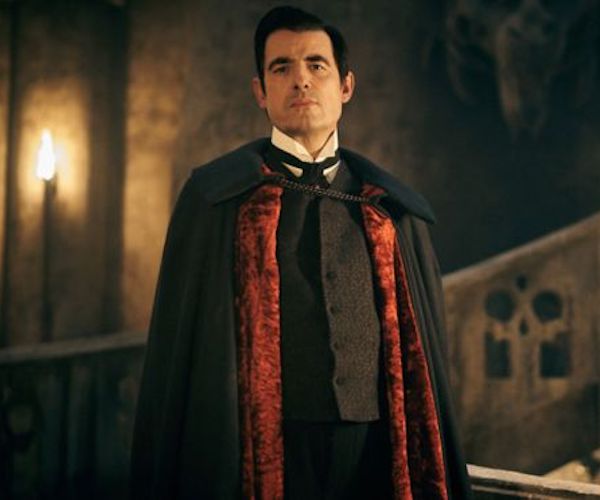Watch Closely: The Latest “Dracula” is Bold and Bloody
By Peg Aloi
This BBC/Netflix production is an audacious rekindling of the undying appeal of literature’s most famous vampire.

Claes Bang in the BBC mini-series Dracula, streaming on Netflix.
The new BBC mini-series Dracula streaming on Netflix is a delectable, binge-worthy effort that updates the classic Gothic story in provocative ways. Told in three episodes that are slightly over an hour apiece, each installment boasts a different setting, and all three locations turn out to be rather mutable and Byzantine, which adds additional twists and turns to the suspense. Viewers who’ve read Bram Stoker’s novel, or seen any number of its cinematic adaptations, will be familiar enough with the main characters to appreciate the clever reinvention of figures like Jonathan Harker, Abraham van Helsing, and Renfield.
The story begins in a convent that’s been housing Harker (played by John Heffernan, seen in the recent series Dickensian and Collateral), who’s been living there as a sort of asylum patient. He’s lost his hair, his pallor is gray, and his face is misshapen: he looks like a corpse. Two nuns sit with him in a room and ask for his account of what he’s been through. They have near at hand a stack of papers he wrote over the last few weeks that detail his experiences. Sister Agatha (Dolly Wells, from Pride and Prejudice and Zombies) is frank and daring in her speech, quipping that she has to have another nun accompany her because she’s not allowed to be alone with men. Agatha questions Harker, and we see in flashback scenes his arrival at Dracula’s castle, an imposing, enormous structure nestled in a mountainous valley. Harker relates he was able to escape after being imprisoned in the castle for over a month. He remembers that he suffered terribly while he was there, but aside from that his memories are fuzzy.
Harker, a lawyer, has traveled from London to visit Dracula in Transylvania to assist with legal matters. At first, the count (played with charismatic aplomb by Danish actor Claes Bang, seen also in The Square) seems to be frail and elderly, as well as somewhat addled mentally. He serves his guest a fine meal, and invites him to stay a few days. Harker refuses, insisting that he must go back the next day. Dracula manages to keep the lawyer there under the pretense of learning better English from him. The days pass, during which Dracula surreptitiously sucks Harker’s blood when he’s sleeping. The lawyer, unaware that his life force is being drained from him nightly, becomes paler and weaker. Dracula, on the other hand, grows younger and more vibrant. Hearing his story, Agatha gently lets Harker know that he has already become undead — thus his frightening appearance. It is also revealed that the man’s lengthy written account, stacks of pages, is gibberish. His mind is being controlled by Dracula.
The second episode begins with a fantastical setup: Dracula and Sister Agatha play chess as they engage in a far-ranging conversation, aspects of which we see played out in flashbacks. We gradually realize that Dracula’s charisma and powers of suggestion are such that he can fool people into thinking they’re in places they’re not — and doing things that they’re not really doing. He has mesmerized Agatha, and their game of cat and mouse plays out as a battle for intellectual and moral dominance. Out of respect for her intelligence and wit, Dracula resists killing the nun. We later discover their deeper connection. Wells is marvelous in this role, her Dutch accent flawless (did I mention Agatha’s surname is van Helsing?), and her self-possessed focus perfect for a nun who reveals that her vocation is more a mode of survival than a true religious calling.
The third episode is the most outrageous, playing fast and loose with the source material to explore Dracula’s timeless appeal. While I preferred the atmospheric charm of the castle and convent settings (they proffer a Hammer Film Productions aesthetic that’s noteworthy and well executed, including plenty of misty stairwells and nubile young women in diaphanous gowns), this imaginative reinvention of the vampire story is clever and suspenseful.
Other characters from the novel appear, too, including Jonathan’s fiancée Mina, Dracula’s henchman Renfield, and the alluring Lucy Westenra. Those viewers who prefer their Dracula as a sexy bad boy (more Frank Langella than Gary Oldman) won’t be disappointed. Bang plays up Dracula’s powerful charm with plenty of nuance and gusto. There’s also lots of engagement with vampire folklore: the mirrors and crosses and shafts of sunlight that keep Dracula and his kind at bay as well as the underlying reasons for these superstitions. I found this British production to be extremely entertaining and well made, with plenty of gruesome and grotesque visuals — it is an audacious rekindling of the undying appeal of literature’s most famous vampire.
Peg Aloi is a former film critic for The Boston Phoenix and member of the Boston Society of Film Critics. She taught film studies in Boston for over a decade. She writes on film, TV, and culture for web publications like Vice, Polygon, Bustle, Mic, The Orlando Weekly, Crooked Marquee, and Bloody Disgusting. Her blog “The Witching Hour” can be found at themediawitch.com.

